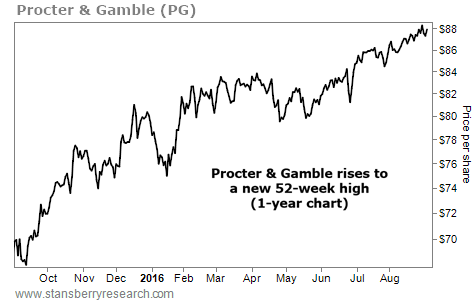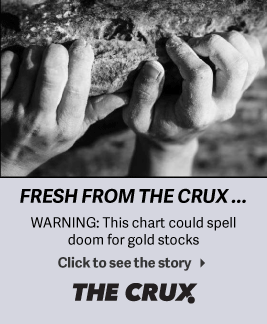| Home | About Us | Resources | Archive | Free Reports | Market Window |
|
Steve's note: Earlier this week, I explained why I believe stocks have plenty of upside ahead. Of course, I can't know the future... And nothing in the market is guaranteed. That's why it's important for you to consider other possibilities. Today, my friend and colleague Dan Ferris discusses an alternate scenario. Taking a longer-term view, he explains some of the dangers in the stock market today. I might not agree with him 100%, but he makes a few strong points that you should consider...
Don't Predict. Prepare.By
Friday, September 2, 2016
I've only done it twice in my career.
But it worked out well both times.
In May 2011, I wrote one issue of the Stansberry Digest, two updates to my Extreme Value subscribers, and nearly an entire monthly issue about the importance and value of holding cash. That was right at the top of the market, before we saw a major 20% plunge in stock prices that lasted until October.
Last November, I wrote an entire issue telling readers why it was so great to hold cash. That was two months before the 10% plunge at the start of this year.
I wasn't predicting market crashes in 2011 and 2015. And I'm not predicting one today. The thing is, you don't need to predict what'll happen in the stock market. You only need to prepare...
Today, you need to prepare for poor returns and lower prices of financial assets.
Returns are low right now across all of the major asset classes. Cash yields zero. Triple A-rated corporate bonds yield about 3.5%. Stocks (as measured by the S&P 500) yield 2.2%. Those are lousy long-term returns, and taxes and inflation will only make them worse.
It has been this way for the last couple years. That's why we've focused on not buying too many stocks in Extreme Value since early 2015, when the vast majority were prohibitively expensive.
Last year, we recommended buying just one stock and selling 15 before the market took a 10% dive from May to August.
In the July issue of Extreme Value, we published four lists of some of the cheapest stocks in the U.S. We looked at the cheapest stocks as defined by their price-to-book ratios... the ones with the lowest ratio of enterprise value to earnings before interest, taxes, depreciation, and amortization (EV/EBITDA)... and the worst-performing stocks of the prior one- and three-year periods.
Nearly all of these companies were value traps. We didn't recommend buying a single one. On average, the best-performing stocks of the four lists fell nearly 12% since then. The worst-performing stocks fell nearly 50% on average.
We told investors to avoid more than 100 stocks last year, and to sell 20 of them... in what turned out to be the worst year for the market since 2008. The market treated readers who took our advice a lot better than it treated most investors.
Of course, we aren't perfect. I have no doubt we'll tell investors to sell and/or avoid stocks sometimes only to watch the market rise. But we don't waste time predicting how stock prices will move in the short term. Neither should you. It's a fool's errand.
Believe me, telling investors to hold plenty of cash and avoid most stocks isn't winning me any friends. And it's certainly not making me lots of money (although, it is keeping me safe from big losses). But it's the primary advice you should be following these days.
We didn't predict that the market would drop. We didn't need to because the data in front of us indicated that stocks weren't a great bet. That's true today, too. And if the market goes up more from here, stocks will become an even worse, more expensive bet.
It's easy to figure out what to do about all this, but hard for most investors to do it: Avoid most stocks. Hold cash and gold. Don't predict. Prepare.
Good investing,
Further Reading:
"I'm praying for another couple of months like August in the stock market," Dan wrote last September, after stocks had fallen as much as 11%. Read more here: Why I'm Thrilled Stocks Are Crashing.
In October, Dan shared his favorite way to reduce risk in the market. "It's an asset that isn't priced in a large, liquid market. There aren't millions of people trading its option value back and forth millions of times a day," he writes. "It has no expiration date. And you aren't locked into buying or selling at a particular time." See which asset he's talking about here: The Most Reliable Way to Reduce Risk in Your Portfolio.
Market NotesTHIS 'BASICS' BUSINESS IS IN AN UPTREND TODAY Today's chart shows us that the timeless strategy of "selling the basics" is still working...
Regular readers know we like to avoid investing in the latest fads and gadgets. Instead, we recommend the "basics" approach of buying dominant businesses that sell "boring" staples... like toothpaste, booze, cigarettes, and cleaning supplies. These companies often make for great investments because demand for their products never goes away.
Take Procter & Gamble (PG), for example. The $233 billion consumer-goods giant owns dozens of brands you probably have at home – including Tide detergent, Bounty paper towels, Old Spice deodorant, and Pampers diapers. It has 21 brands that generate $1 billion or more in sales each year.
As you can see below, selling the basics continues to work for Procter & Gamble. In the past year, shares have climbed more than 25% and recently hit a new 52-week high. It's more reason to stick to the basics...
 |
Recent Articles
|



